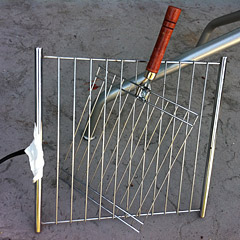Posted: February 20th, 2012 | Author: Nathan | Filed under: field recording, nature recording, sound design
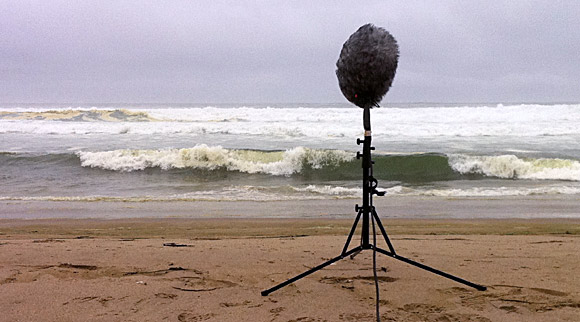
Look carefully: Deep impact zone, short period, wind parallel to the shoreline. Not a good day for recording single waves. So...what is?
It’s easy to get recordings of roaring surf – which can often just sound like constant white noise – but it can be tough to get relatively clean recordings of individual waves. I’ve found that picking a good day and place to record single wave hits are a combination of marine forecasts and location, and that the size of the waves really doesn’t matter.
The only online article I’ve seen that mentions both field recording and marine forecasting has been published by Tim Prebble. In that excellent article, he describes finding gentle-surf days to record his amazing Seal Vocals SFX library. Sometimes finding those small- to moderate-swell days are sometimes the best days to record single wave crashes…but that’s not the only factor.
Single-wave recording conditions are largely defined by a mix of swell, wind, and location.
Swell is due to the large movements of water over great difference; swell is not the same as waves, which are usually wind-driven. Swell is usually forecast based on buoys offshore, and is forecast days in advance. However, I find that 2-day swell forecasts are the most accurate. Swell is defined by wavelength and amplitude, just like audio: Wavelength is is measured in seconds (usually called period), and amplitude (usually called height) is based in feet or meters. Ideally, you want swell with long periods, because that means there’s a greater volume of water moving, but tall swell is also your friend, because that also influences breaking-wave heights at the shore. (Tip: Waves come in “sets” of big and small, between 3 and 8 waves each, depending on if there are multiple wavetrains that are in or out of sync. That means record for far longer than you’d otherwise think in order to get a good range of big vs. small waves over time.)
Getting back to the topic of wind, not all wind is bad (and we all know what wind does to field recordings: huge amounts of badness.) Offshore winds (those that come off of the shore – yes, that is totally confusing!) will might wave faces up longer than they’d be up otherwise, causing a moment of quiet before the wave breaks (or “closes out,” in surf parlance) and a potentially taller wave face. Wind coming onshore (onto the shore from the water) often smears the wave tops and can cause premature toppling…not to mention the fact that the wind will be blowing directly at your microphone capsules. (Tip: You can’t be at the shore without shorebirds, often noisy ones. Bird feeding activity, and therefore noise, may peak before an oncoming storm. Watch the forecast and choose clear weeks with low-pressure days, when it requires more energy to fly, when possible to reduce avian noise. Gulls are complete bastards in this regard!)
Finally, this brings us to location. Some of this is taste: Do you want to record breaking waves against sand, or against rock? Very different sounds will come out of each; bigger crashes will happen on rocks as opposed to sand. But beyond that, know a bit about your location. What direction is the swell and wind coming from, relative to where you’ll be facing? How does the land curve around, creating refraction waves? What is the slant of the land below the shoreline? This last one is especially critical, as the gentler the slope, the bigger the wave. The “impact zone” – where the waves actually break – can be deep or narrow, and a narrower impact zone will generate fewer audible breaking waves at once. Knowing if a beach has a “dumping break” is useful: It makes it terrible to launch from or surf near, but that also means the waves break right at the shoreline, which is far better for audio recording. Just watch out for your gear. (Not a tip, but trivia: Waves always break when the water depth is 1.3x to 1.5x the wave height, as the horizontal energy of the swell gets forced upwards to create breaking-wave heights near shore.)
Never turn your back to the sea. The sea is huge, powerful, indifferent, and above all, unpredictable. Rogue and “sneaker” waves are not legends or myths: They occur regularly, anywhere in the world. Don’t let a recording session end in tragedy.
A final note on technique: If you’re on a beach, angle the mic a bit more downwards than you’d think would be wise, and you’ll get nice sounds of the sand being pulled back as the breaking waves recede back into the ocean. Not always good to have in every recording, but this adds a lot more character. On a beach with fist-sized rocks, this can be especially cool!
I had a recent session at a sandy beach in the Point Reyes National Seashore that exemplified some of the better (but not quite perfect) conditions that I describe above. First, the wind was blowing at 20 knots…but from the opposite direction of the beach I was on, which was backed by hills. That meant delayed wave breaks and being protected from the wind. There was a southerly swell that came right into the dumping-break beach (I can tell the period is averaging 14 seconds by looking at the waveforms of the audio!), so it was all breaking swell and no wind-driven waves. It was a low-pressure day with a long-term clear forecast, and it wasn’t winter, when the masses of migratory birds come through Northern California. Only one swallow’s call made it into the recording.
The recordings aren’t all that dramatic when you consider the breaking waves were only 3-4′ high. But listening to this loud on headphones, eyes closed, I find that the sense of scale is quite exaggerated without an accompanying visual reference…a little Waves LoAir or layering some low-frequency booms can definitely can tip it into cinematically-big breaker territory if desired. However, even in a 90-second clip, there are only three really distinct wave “claps” as the bigger waves close out at the beach.
[Sennheiser MKH 30/50 mid-side stereo pair into Sound Devices 702 recorder]
Tags: field recording, nature, nature recording, ocean, sound design, sound effects, surf, water | 3 Comments »
Posted: October 13th, 2011 | Author: Nathan | Filed under: found sound objects, sound design
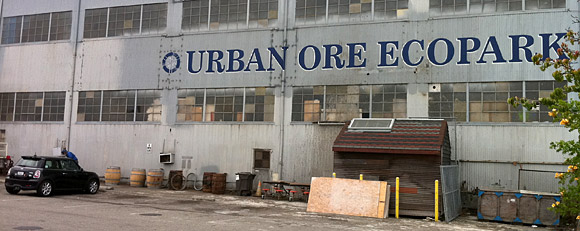
My mecca on a foggy morning: Urban Ore!
I went to the granddaddy of thrift stores recently, so much so that it’s more of a glorified junk store…but oh, what glorious junk. I’m talking about Urban Ore in Berkeley, California. Sometimes I’m self-conscious shopping for things by ear, picking up random things and just listening to them, but at Urban Ore – heck, Berkeley in general – I can ear-shop in peace.
I was in a metallic mood, so I filled a bag with things that squeak, resonate, creak, clank, and sproing. Based on the dronetastic results of striking wire shelving last year, I picked up a few thin-wire metal grills that had sonic promise, among other things that will surely find their way to this blog later this fall and winter.
For the grills, I decided to trot out my much-neglected piezo contact microphones. The resonant notes were so subtle that it seemed like the best way to capture the sound at a reasonable volume. I plucked them, struck them, and played them with a cello bow. The magic happened, though, when I realized one was easily played with a bow and the other was not, so I stuck the bowable one inside of the other, and played away, causing both of them to resonate when played appropriately.
The results were like ultra-low-fi bastardizations of stringed instruments played in horror movies, and I just loved the character. The rawness of hearing the actual hairs of the bow on the metal, in my opinion, lends to the eerie charm.
[soundcloud url=”http://api.soundcloud.com/tracks/25407627″ params=”show_comments=true&auto_play=false&color=ee0000″ width=”100%” height=”81″ ]
[Contact microphone into Sound Devices 702 recorder]
Tags: creepy, digital audio, eerie, found object, groaning, horror, metal, resonance, sound design, sound effects | No Comments »
Posted: August 2nd, 2011 | Author: Nathan | Filed under: field recording, sound design
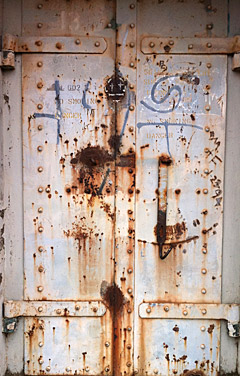
Rusty? Heavy? Covered in graffiti? You KNOW it will sound good.
Many people are unaware that the San Francisco Bay Area was once thoroughly fortified against attacks from the sea. Remnants of this past dot the entrance to the Golden Gate, in the form of bunkers that once housed gun emplacements.
One such installation was Battery Yates at Fort Baker. Located at the best vantage point for southward-facing photos of the Golden Gate Bridge, Battery Yates was meant for nothing other than picking off minesweepers that might try to get through the minefields inside the ‘Gate in wartime…minesweepers, of course, that would never come.
Battery Yates was active from 1905 through 1946. Now, only the U.S. Coast Guard maintains a station at Fort Baker, primarily for saving the lives of boaters and wind/kitesurfers. Now Battery Yates is a tourist attraction, is fun to scramble on and around…and, in swords to ploughshares style, is also a great source for cool sounds!
Each of the gun emplacements has four lockers, each sealed with a massive steel door. Some doors have outer latches that have been left to swing freely in favor of just welding the doors shut. These latches, rusted by more than 60 years of salty mist, are quite expressive when swung, manipulated, and otherwise mishandled. The perfectly square concrete rooms behind these doors caused them to have a lot of low end and resonance.
I decided to try my luck with recording some groaning metal effects on these doors, despite the fact that:
- I only had some time before work one weekday, which meant that…
- I could only record during rush hour, made worse by the fact that…
- The Golden Gate Bridge is only 1/8 of a mile away, plainly visible from the recording site.
All this meant lots of background traffic noise. I mitigated these risks by using a hypercardioid microphone for off-axis rejection of sound (a shotgun would have been a better choice in terms of pattern, but I just loved the sound of my MKH-50 too much to not use it), careful placement of the mic relative to the bridge (making sure that either the mic element faced away from the bridge or a thick concrete wall blocked line of sight), and the judicious use of the Denoiser plugin from iZotope RX. And, for effects like these, the small-condenser-mic proximity effect only helps!
The result came out pretty well, all things considered…although the editing in today’s post is pretty sloppy, so apologies for that. Everything was recorded at 24-bit, 192-kHz, as best befits complex groaning metal sounds, since pitching this stuff down can yield pure sound-design gold. I recorded even more massive metal hits from this session, which may be a topic for a separate post… (And until then, you can hear yet more heavy metal hits/impacts here, here, and here.)
[soundcloud url=”http://api.soundcloud.com/tracks/20003445″ params=”show_comments=true&auto_play=false&color=ee0000″ width=”100%” height=”81″ ]
[MKH 50 microphone into Sound Devices 702]
Tags: field recording, groaning, industrial, metal, noise reduction, resonance, San Francisco, sound design, sound effects, urban | 4 Comments »
Posted: June 5th, 2011 | Author: Nathan | Filed under: field recording, nature recording

Thus quoth the raven, "Press record, idiot!" (This picture was taken years ago in Oakland, CA, not where today's sound was recorded.)
[One in a series of posts from my spring 2011 trip to the southern California desert.]
I love ravens. Not because I’m all Mr. Gothy McLordbyron, but because they’re big, majestic, smart as hell, and have gravelly voices. Like crows, but drunker. They’re the Tom Waits of the bird world.
Ravens aren’t exactly rare, and perhaps because of this, they’re hard to record in the wild. They can be anywhere: Urban areas, tops of trees, windswept hills…but by the time I show up with a recorder, they’re either deciding to be quiet or are surrounded by traffic noise, intense winds, other birds, or even people. I’ve had the darnedest time capturing one cleanly.
Thankfully, the ravens of Joshua Tree National Park are pretty fearless…well, they’re also always looking for snacks, and have learned that people can be a good source for tasty (dropped) morsels. I’ve noticed that they often travel in pairs or groups of less than four to six, and one day we were followed by a pair of ravens as we wandered the desert trails. The vocalizations aren’t anything super-special, but they’re (for once) pretty clean, articulate, and detailed. Just what I was hoping for!
This raven was talking to his companion quietly as they spread out looking for snacks. He landed about twenty feet from me and I recorded him as he was hopping around. I like the little lilt he added at the end!
[soundcloud url=”http://api.soundcloud.com/tracks/13996270″ params=”show_comments=true&auto_play=false&color=ee0000″ width=”100%” height=”81″ ]
[Sony PCM-D50 recorder, capsules at 120°]
Tags: animals, birds, birdsong, desert, digital audio, joshua tree, nature recording, sound effects | No Comments »
Posted: May 12th, 2011 | Author: Nathan | Filed under: field recording, found sound objects, sound design
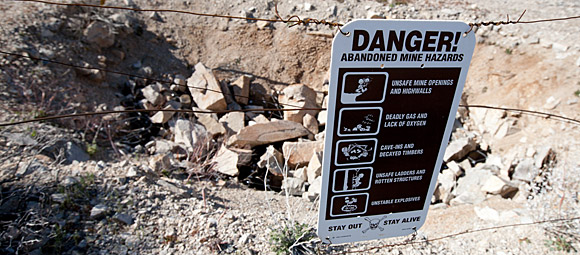
Eton Mine, Lucky Boy Trail, Joshua Tree National Park, California, USA.
[One in a series of posts from my spring 2011 trip to the southern California desert.]
Joshua Tree National Park is beautiful, but much of its history (prior to being designated a National Park) has scarred and pockmarked its landscape. In the Gold Rush, the Joshua Tree hinterlands held some of the most productive mines in California until well into the 1900’s. These mines were big, sprawling, and deep. To my knowledge, no Balrogs were released as a result. But that would explain a lot about Golden State politics.
We hiked on some lesser-traveled trails and found an acre of land with no fewer than five vertical holes in the ground: Mine shafts. They were all wired off and had metal grates over them. One in particular, the Eton Mine on the Lucky Boy trail, had warning signs on the wire fence surrounding it.
It was quite windy that day, and I just knew I had to get the creaking, squeaking sounds of this battered sign on the rusty wire. It took me a surprisingly long time to figure out how to protect my handheld recorder from the wind, but ultimately I decided to use my body as a shield and then stick it under my microfleece hoody. (I had the OEM fuzzy windscreen on it, which is one of the most useless strips of fabric I’ve ever seen, er, heard.) I just hoped that my body protected it from the 25+ mph wind gusts and that the fabric wouldn’t dampen the high frequencies too badly…and because of the sound, I had high-frequency content to burn.
With some judicious noise reduction in post – subtle, as always, gives the best result – it didn’t come out too shabby, considering the horrible recording conditions and super-no-budget wind blocking techniques!
[soundcloud url=”http://api.soundcloud.com/tracks/15163504″ params=”show_comments=true&auto_play=false&color=ee0000″ width=”100%” height=”81″ ]
[Sony PCM-D50 recorder, capsules at 120°]
Tags: creepy, desert, digital audio, eerie, field recording, found object, industrial, joshua tree, metal, resonance, sound design, sound effects, travel | 1 Comment »
Posted: May 4th, 2011 | Author: Nathan | Filed under: field recording, found sound objects, sound design

"Ol' Wheezy" the Water Spigot, as we called him, at our campground in the desert.
[One in a series of posts from my spring 2011 trip to the southern California desert.]
Joshua Tree National Park is in the Mojave Desert. It’s dry. Only two campgrounds in the entire park have running water of any kind. Bad weather on the coast of California caused us to decide to stay in the desert at the tail end of a week’s vacation, so we were lucky to just show up at Joshua Tree and grab a spot at one of these prime campgrounds.
I camp a lot, all over the place, but I had never seen a water spigot quite like the one near our site. It was like the wet dream of a post-apocalytpic film production designer: Big, industrial, heavy, and red. If a common water pump could be bad ass, this one could.
Anyway, the draw-up of water sounded really neat, so I whipped out the ol’ handheld recorder and took some samples on our last morning there. It reminded me a bit of the sound of EVE coming out of her landing ship’s tube from the film WALL•E.
In developed campgrounds, you need to be up really early to avoid noise from fellow campers. No wonder I like backpacking so much…
[soundcloud url=”http://api.soundcloud.com/tracks/13996448″ params=”show_comments=true&auto_play=false&color=ee0000″ width=”100%” height=”81″ ]
[Sony PCM-D50 recorder, capsules at 120°]
Tags: desert, digital audio, field recording, industrial, joshua tree, machine, sound design, sound effects, travel, whoosh | 6 Comments »
Posted: April 25th, 2011 | Author: Nathan | Filed under: field recording, nature recording
[One in a series of posts from my spring 2011 trip to the southern California desert.]
Anza Borrego Desert State Park is the second largest state park in the lower 48 United States. It’s dry, as its name implies, but it’s very seismically active and has many natural hot springs and oases scattered throughout the park, so water is less scarce than you’d think.
Even so, it shocked me almost beyond belief how filled some of these hot seeps were with frogs, and how loud they got at night. Sadly, I didn’t get any pictures of these tiny thumb-sized frogs, puffing out their chins to impress their ladyfriends, but I watched them for an hour with my headlamp while I recorded them from several perspectives. (Tip: Get a headlamp with a red LED or filter. This goes a long way in preserving your night vision while still illuminating nearby things like field recorder controls, and tends to spook animals less.)
Here is one long take from this session. It starts with distant frogs, one slow croaker nearby, and then gets really hopping (ugh, sorry, I had to do it) around 1 minute in. Then, after two and a half minutes, it dies down as quickly as it started.
[soundcloud url=”http://api.soundcloud.com/tracks/13996065″ params=”show_comments=true&auto_play=false&color=ee0000″ width=”100%” height=”81″ ]
[Sony PCM-D50 recorder, capsules at 120°]
Tags: desert, digital audio, field recording, frog, joshua tree, nature, nature recording, sound design, sound effects, travel | 5 Comments »
Posted: January 20th, 2011 | Author: Nathan | Filed under: found sound objects, sound design

Mr. Heater, the oddest and loudest camping stove ever.
One of the guys at work loves camping gadgets (as do I), and he shared a video of his odd little Mr. Heater camp stove making some weird unholy racket. Naturally, I asked to borrow it and did some recording sessions with it over the holidays.
A metal reflector lets the unit be used as either a heater or a camp stove. This ring of steel doesn’t make much sound when it’s running (all you hear is the hiss of gas emission, much like this recording), but it sure resonates when the stove fires up, starting as one tone and diverging into two separate tones, creating a harmony. Very effective or driving away bears, or as a means for summoning the dead.
The only processing applied to this sound is some noise reduction to minimize the gas regulator’s hiss, to pull the resonance forward. Recorded at 192kHz, a clip like this is ripe for pitch shifting for even scarier tones! (Mic placement was tricky; placing the mics right in front would melt them instantly.)
[soundcloud url=”http://api.soundcloud.com/tracks/9154382″ params=”show_comments=true&auto_play=false&color=ee0000″ width=”100%” height=”81″ ]
[Sennheiser MKH 50/30 pair, rigged for mid-side stereo, into a Sound Devices 702 recorder]
Tags: field recording, industrial, metal, resonance, sci-fi, sound design, sound effects | 5 Comments »
Posted: January 12th, 2011 | Author: Nathan | Filed under: field recording, sound design

Yes, the Noise Jockey Corporate Yacht follows the Noise Jockey Online Branding and Color Usage Guidelines.
Kayaking on the Whiskeytown Reservoir in Northern California, I was surrounded by motorboats pulling wakeboarders. I wanted to see what all those speedboats sounded like underwater, so I dropped my hydrophone over the side and took a listen (with my field recorder safely under the deck of my kayak, in a dry bag). The inboard engines emitted a clean, high-tech whine with none of the chunky, air-gulping combustion engine sounds we typically hear in the air. “Spaceship,” I instantly thought.
I merged two recordings of these motorboats, each about half a kilometer away, futzed with them just a tad (sorry, my effects chain is lost to the dim mists of time!), and turned it into a loopable drone.
[soundcloud url=”http://api.soundcloud.com/tracks/8232669″ params=”show_comments=true&auto_play=false&color=ee0000″ width=”100%” height=”81″ ]
[Aquarian Audio H2a-XLR hydrophone into a Sound Devices 702 recorder]
Tags: field recording, hydrophone, lake, motorboat, sound design, sound effects, spaceship, water | 4 Comments »
Posted: December 20th, 2010 | Author: Nathan | Filed under: found sound objects, sound design
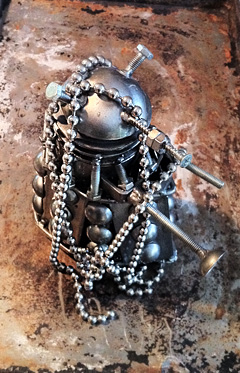
Exterminate! Exterminate!
In North America, the end of the Western calendar year brings Thanksgiving, Hanukkah, Kwanza, Christmas…lots of holidays, most of which revolve around eating. In our household, that means one thing above all else: PIE SEASON.
My wife loves making pies and tarts, and one of the baker’s secret weapons for such endeavors are pie weights. They’re simply large, heavy versions of the more common metal-ball-style keychain. Ours is about four feet in length.
While washing dishes after a piemaking bonanza, I noticed the sound it made as I dragged it over the lip of our stainless steel sink. Finally, on a rainy winter day, I decided to do some recording and processing.
I grabbed three things for this session: The pie weights, a really beat-up baking sheet, and a small model of a Dalek made from spare parts (a gift from a dear friend). I simply moved the pie weights across each of these objects in different ways. Hot metal-on-metal action!
The balls on the pie weights made a great ratcheting sound that instantly made me think of a castle portcullis being raised and lowered, or a ship’s winch retracting an anchor. Of course, the size of these weights made pretty bright sounds, but that’s what pitch shifting is for…
So, today’s sound is a mix of these sounds, some raw, and some pitched down significantly. I didn’t do anything besides pitch shifting and EQ, just to show how flexible these high-frequency, detailed sounds can be when recorded at 192kHz. These sounds were recorded with a large-diaphragm condenser mic, because I found that proximity effect from close-miking with a small-diaphragm condenser produced too much bass to provide the balanced, bright sounds that I was going after.
[soundcloud url=”http://api.soundcloud.com/tracks/8225412″ params=”show_comments=true&auto_play=false&color=ff7700″ width=”100%” height=”81″ ]
[Røde NT1a microphone into Sound Devices 702 recorder]
Tags: dalek, digital audio, field recording, industrial, machine, metal, pie, sound design, sound effects | 5 Comments »


